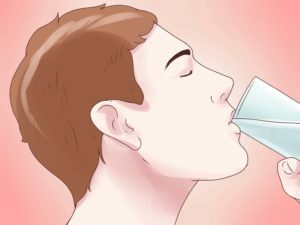 Rinses after tooth extraction can be called a "double-edged sword", since in addition to the benefits, they can cause significant harm.
Rinses after tooth extraction can be called a "double-edged sword", since in addition to the benefits, they can cause significant harm.
To avoid this, it is necessary to follow all the recommendations of the doctor, taking into account the specifics of the procedure.
Most dentists recommend patients who have had an operation to remove the tooth, for several days to rinse the mouth with healing and anti-inflammatory compounds.
But such procedure has a number of features, ignorance of which can lead to negative consequences and development of complications. How to properly rinse, and what tools are suitable for this?
Contents
- Rinse with the mind
- Traditional rinse preparations
- Use chlorhexidine
- Miramistin
- Furacilin
- Potassium permanganate
- Traditional medicine recipes
- How to perform the procedure correctly?
- What should I do for complications?
Rinse with the mind
The first question, which is it worth to answer if you can rinse your mouth after tooth extraction and when?
Two days of rinsing give the following results:
-
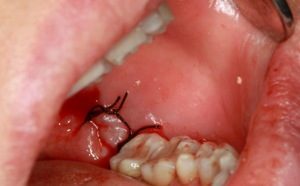 interferes with the development of inflammation;
interferes with the development of inflammation; - accelerate the healing of injured tissues;
- help to improve overall health.
As a result, the oral cavity is regularly cleaned of food debris, harmful microorganisms that can cause infection of the well.
In addition, medicinal or herbal formulations contribute to the rapid tightening of the well.
What is the best way to rinse your mouth after tooth extraction? As a rule, dentists prescribe drugs that simultaneously disinfect the oral cavity and relieve inflammation. Along with the medicinal forms, decoctions of herbs are used.
Traditional rinse preparations
The following mouthwash solutions after tooth extraction are especially effective: Chlorhexidine, Miramistin, Furacilin, Potassium permanganate.
Use of Chlorhexidine
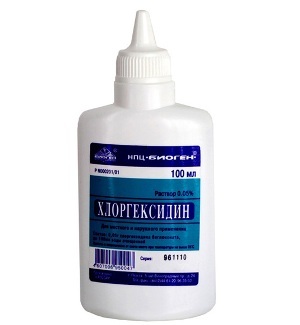 You can use the drug both in pure form and in formulations, where it is one of the active substances( Sebidine, Hexicon).Dentistry uses aqueous solutions of 0.05% concentration.
You can use the drug both in pure form and in formulations, where it is one of the active substances( Sebidine, Hexicon).Dentistry uses aqueous solutions of 0.05% concentration.
Many of the microorganisms present in the oral cavity are susceptible to chlorhexidine, with the exception of viruses and fungi.
The main purpose of the drug is disinfection. Among the unique properties of chlorhexidine, its activity can be noted even in the presence of pus or blood in the hole.
The action of the remedy is prolonged for a couple of hours because of its presence on the oral mucosa after rinsing. The frequency of rinses with chlorhexidine is 2-3 times a day( the solution is taken in the mouth and held for 2 minutes).
Miramistin
Is an active antiseptic and helps to neutralize the action of Gram-positive and Gram-negative microorganisms, a number of viruses and yeast-like fungi. In addition, Miramistin promotes normalization of local immunity, rapid healing of the wells. The drug is effective even if there is purulent content in the well.
The form of Miramistin release is aerosols for irrigation and bottles with a rinse solution.
Furacilin
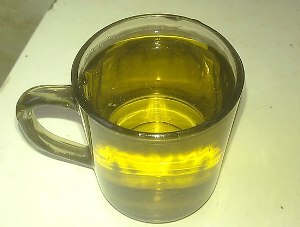 Furacilin or nitrofural has antiseptic properties, contributing to the elimination of pathogenic microorganisms and improvement in the development of a purulent-inflammatory complication.
Furacilin or nitrofural has antiseptic properties, contributing to the elimination of pathogenic microorganisms and improvement in the development of a purulent-inflammatory complication.
For rinses, 10 tablets are dissolved in a liter of water, adding a teaspoon of salt.
For rapid dissolution, it is advisable to use hot water.
Potassium permanganate
A remedy known to many as "potassium permanganate", is an excellent antiseptic. The ability to suppress the inflammatory process is due to the binding of the protein fraction in the oxidation of potassium permanganate and the liberation in the process of atomic oxygen.
Recipes of traditional medicine
How can I gargle gums after tooth extraction without using pharmaceutical preparations? You can prepare solutions for rinsing yourself, using improvised soda and salt, or various herbs.
Most popular solutions:
- Soda-salt solution .In a glass of slightly warm water, dissolve one teaspoon of soda and salt( the salt can be replaced with 3-5
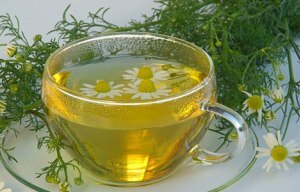 drops of iodine).Such a solution is a weak antiseptic and is effective for preventing inflammation or its elimination during the course in a mild form.
drops of iodine).Such a solution is a weak antiseptic and is effective for preventing inflammation or its elimination during the course in a mild form. - Herbal decoctions of .For the fastest healing of the gums use herbal tea. They are prepared from the anti-inflammatory and disinfectant properties of pharmacy chamomile, calendula, eucalyptus, sage. A tablespoon of grass is poured into a glass of hot water, brought to a boil, removed from the plate and left for infusion for a couple of hours, wrapped in a warm blanket or towel. For rinses, the infusion is filtered and used in a warm form. In a day to conduct the procedure is desirable after each meal, but not more than 4 times.
Do I need to rinse my mouth after removal and other recommendations from a dentist:
How to proceed correctly?
When rinsing a doctor, it is important to remember that this is not about intensive rinsing, but about light exposure to injured tissues for the purpose of their early healing.
Rinses may be taken after meals three times a day using a room temperature solution. The use of food and drinks is allowed after 30 minutes.
What to do in case of complications?
One of the most common complications after tooth extraction is the appearance of purulent contents in the well. The cause of the development of the purulent-inflammatory process( alveolitis) may become insufficient or, conversely, too zealous hygiene( too frequent and active rinsing), damage to the socket and the loss of the clot during meals.
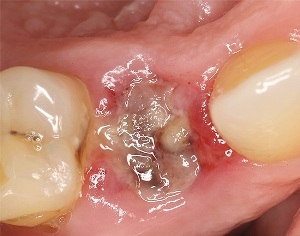
Alveolitis
To rinse in this situation before a visit to the dentist, you can and even need it, since it is necessary to clean the hole from the pus.
The most suitable solutions are Chlorhexidine, Miramistin, Furacilin or chamomile broth.
But completely eliminating the inflammatory process of rinsing will not help, therefore they are used as an auxiliary therapy, necessarily referring to a specialist who will thoroughly clean the wound surface and make the necessary manipulations to form a new blood clot in the hole.
Care of the oral cavity after tooth extraction should be done as carefully as possible, since the main principle is "do no harm".
Only the right approach and following the recommendations will provide an effective result in the form of fast healing of the socket and restoration of the gingival tissue.
